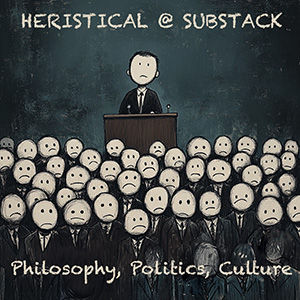
Many would think that the finest decades of Oxford philosophy were the post war period, the Oxford of linguistic philosophy, where Gilbert Ryle, A.J. (Freddie) Ayer, John Austin, Richard Hare, and Herbert Hart practiced a kind of conceptual analysis. Benjamin Lipscomb’s The Women Are Up to Something: How Elizabeth Anscombe, Philippa Foot, Mary Midgley and Iris Murdoch Revolutionized Ethics is a welcome corrective to that male-dominant narrative. The story is fascinating and important. Four brilliant Oxford undergraduate women were able to flourish in the early 1940s. Each would become a renowned philosopher, making their way in an academic world unwelcoming to women. One of them, Mary Midgely, explained that it was only possible because the men were off at war, their absence making it “a great deal easier for a woman to be heard in discussion … Sheer loudness of voice has a lot to do with the difficulty, but there is also a temperamental difference about confidence – about the amount of work that one thinks is needed to make one’s opinion worth hearing.”
The biographical aspect of Lipscomb’s book is excellent. The four women shared much. They had, in Murdoch’s words, an “intellectual intimacy.” Murdoch and Foot also had an experimental physical intimacy and we learn of Murdoch’s infatuation with Anscombe – one that might have resulted in a brief romantic, but non-physical, relationship. They were all feminists of various kinds. And while we now think of these women as having been hugely confident – downright intimidating in Anscombe’s case – they shared a tendency towards insecurity. The story of Murdoch’s anguished self-doubt while preparing her Gifford Lectures, The Metaphysics of Morals, is particularly striking. But Lipscomb makes it clear that they all had their anxieties and difficulties, including Midgely’s struggle to re-enter professional philosophy as an interdisciplinary thinker after she took a long break from academia to raise her family. These stories are interesting for their own sake, but also heartening for women who suffer still today from such feelings and problems.
Some of the tales Lipscomb tells are familiar pieces of philosophical lore, such as those about Anscombe’s liberal childrearing and fantastically dirty house. (The philosopher J.J. MacIntosh told me that when he was a student in Oxford, he went to tea there and was told by Elizabeth to “move that pile of paper from the chair” so he could sit. The pile was an original manuscript of Wittgenstein’s. One wonders how much was lost in the debris.) Some of the stories are new. We hear about Foot’s quiet act of kindness in giving up half her position and most of her salary at Somerville College so that Anscombe could have a job. We learn about the now forgotten but then influential, intense, and eccentric Oxford philosopher Donald MacKinnon, who would give his tutorials lying prone on the floor or curled up in a ball, a practice Murdoch for a time imitated. We discover that during the war, Murdoch “offered herself as a low-level spy for the Communist Party, copying Treasury documents and leaving them in a hollow tree in Kensington Gardens for a fellow agent to collect.” We get moving accounts about what became of the four women and their friendships as they aged. We are told a wonderful anecdote about the highly proper and aristocratic Foot setting aright a reactionary don at Corpus high table, who was making Foot’s former student Rosalind Hursthouse miserable in the college. When he suggested that the National Guard had acted appropriately in shooting student demonstrators at Kent State because the students were throwing rocks, Foot granted, in her cut-glass accent, that they had indeed been rude. They had called the police “motherfuckers,” but “If I were to call you a motherfucker, you wouldn’t think you would be justified in shooting me, would you?” Put in his place, he stopped tormenting Hursthouse.
Lipscomb has a philosophical story to tell as well. The central argument of the book is that the four women ushered in a “paradigm shift” against the orthodoxy of the time. He sometimes calls that orthodoxy the “billiard ball” picture of truth and objectivity, where the stuff of the world is physical matter, devoid of value, leaving ethical discourse meaningless. This picture, Lipscomb says, not only failed to help people think through their most urgent questions, but rather, it undercut such thinking. It “glamorized” what he calls, rather anachronistically, the “Dawkins Sublime,” (after Richard Dawkins) where nothing is real or important but the objects of the hard sciences. Ayer, the Vienna Circle’s man in Oxford, was promoting such a view, on which ethics is mere expression of emotion, along with Hare, who argued that there are no ethical facts, but merely the commitments of individuals who must make up their own minds about how to live and then follow the rational entailments of those commitments.
Lipscomb argues that the four women had a shared critique of the orthodoxy and held out the possibility of an alternative to subjective ethics. It was the images from Buchenwald and Bergen-Belsen, he suggests, that were responsible for their approach. The billiard ball picture was incompatible with making moral judgments about the Holocaust and incompatible with the political idealism and activism of the four women. Foot did a huge amount for Oxfam. Midgely was active in animal rights and Murdoch in Communist politics. Anscombe tried to prevent Truman from receiving an honorary degree from Oxford because of his deadly atomic bombing of Hiroshima and Nagasaki. Lipscomb’s thesis is that the four women sought a philosophy that could lead to people being moralists, not nihilists, by developing versions of “ethical naturalism” that are only getting a hearing now.
Foot set herself against the idea that fact language and value language could be neatly separated. When we call an action “rude we both describe and criticise it. She developed a virtue ethics in which morality is a natural phenomenon grounded in facts about human concerns. Midgely viewed human behaviour in the context of biology – hers was a naturalist ethics grounded in what it is to be a human animal. Murdoch’s verdict on Ryle (and Lipscomb takes it to be just as powerful against Austin) was that his world was one “in which people play cricket, cook cakes, make simple decisions … not the world in which they commit sins, fall in love, say prayers, or join the Communist Party.” Anscombe roamed across a wider swath of the philosophical landscape, but on ethics, she bemoaned the state of modern Oxford moral philosophy as being the stuff of her adversary, Austin, who she saw as making absurdly fine distinctions that turned philosophy into dictionary work.
This all seems right on the surface, although one wishes for a little more depth. Lipscomb mentions that of course the billiard ball philosophers had convictions about how to live. But this presents a deep puzzle that one would have liked to see examined. At the very least, it complicates Lipscomb’s philosophical narrative. Those in the grip of the picture that is supposed to result in inaction on the ethical stage were progressive socialists for the most part, heavily involved on the ground in political and ethical matters. Ayer was a left-wing activist and agitated against appeasement. The members of the Vienna Circle objected, in strong words and actions, to Nazism. Those who manged to flee (often to America) were engaged in progressive politics there. Hare had been a prisoner of war, building the Burma-Thailand railway under inhuman conditions, doing countless good deeds for his fellow POWs along the way. He worked out his philosophical theory during this time and would become a leading utilitarian in the 20th century, a philosophical project deeply committed to social reform and individual improvement. He wrote papers on topics ranging from slavery to abortion to whether we shouldn’t eat animals.
Do we not require an explanation for how the billiard ball theory, so apparently bloodless for ethics, could be believed by philosophers acting so powerfully at the moral coalface, at the place where whatever views they had about ethics met practical problems? However inconsistent Lipscomb might find the positions of the billiard ball enthusiasts, one wants from him some account of what was really going on with them, not the false idea that they thought ethics is a wasteland. For clearly it was not.
One possible answer was given by Wittgenstein in the Tractatus, in which he too set out a picture of the relationship of language and the world, in which all meaningful propositions can be reduced to elementary propositions which correspond to simple objects in the world. He argued that ethical and religious statements are nonsense, but a special kind of ineffable and important nonsense that only can be gestured at, not spoken about. Here’s another possible answer. Ayer and the members of the Vienna Circle found it liberating to distinguish fact from value, so that they could escape the constraints of the so-called ethical facts, which were lodged within a religious framework that dictated what was right and what was wrong.
Indeed, Anscombe was locked into such a framework – the Catholic one. She was a vehement opponent of abortion, blocking clinics and going out of her way to abuse pro-choice advocates. It was exactly these kinds of “objective” moral prisons from which Ayer and the Vienna Circle were trying to escape. (Anscombe was ethically challenged in other ways as well. Lipscomb relates how she berated and discarded a good friend when the friend married Austin, whom she loathed. Her neighbour, the literary critic John Cary, asked the unruly Anscombe/Geach household to stop blasting music from open windows at all hours. He was told by one of the many children that it was “no good” complaining about that, as “the whole street got up a petition about us once, but it didn’t have any effect.”)
The second problem with Lipscomb’s philosophical argument is that, while the four women did hugely important work, it doesn’t seem right to say they effected a revolution – a change in the very way in which we think. Frank Ramsey from the 1920s and Wittgenstein from the 1930s had also been pushing for a focus on the particular. Sure, they were Cambridge philosophers, but everyone in 1940s Oxford was reading them. Indeed, Lipscomb recounts how Anscombe went to Cambridge after her undergraduate degree and fell under the spell of Wittgenstein, becoming one of his favourite and most successful pupils. When she returned to Oxford in 1946 “as Wittgenstein’s apostle to Oxford, she would help her friends see an alternative to the theory of ethics ascending there.” So was Wittgenstein the real revolutionary? We cannot say even that. Dewey in America was a strong philosophical voice against the fact/value dichotomy and for an ethics grounded in particular, down to earth, human experience before Wittgenstein. I’m sure we can go back even further. Perhaps the revolution was just within the bounds of Oxford city limits. Such are the perils of trying to identify and name a moment, a turning point, in the history of thought.
The Women Are Up to Something: How Elizabeth Anscombe, Philippa Foot, Mary Midgley and Iris Murdoch Revolutionized Ethics, by Benjamin J. B. Lipscomb (Oxford University Press), $27.95/£20
Cheryl Misak is University Professor and Professor of Philosophy at the University of Toronto. She works on American pragmatism, the history of analytic philosophy, ethics, and the philosophy of medicine. Her latest book is the biography Frank Ramsey: A Sheer Excess of Powers (Oxford University Press).

